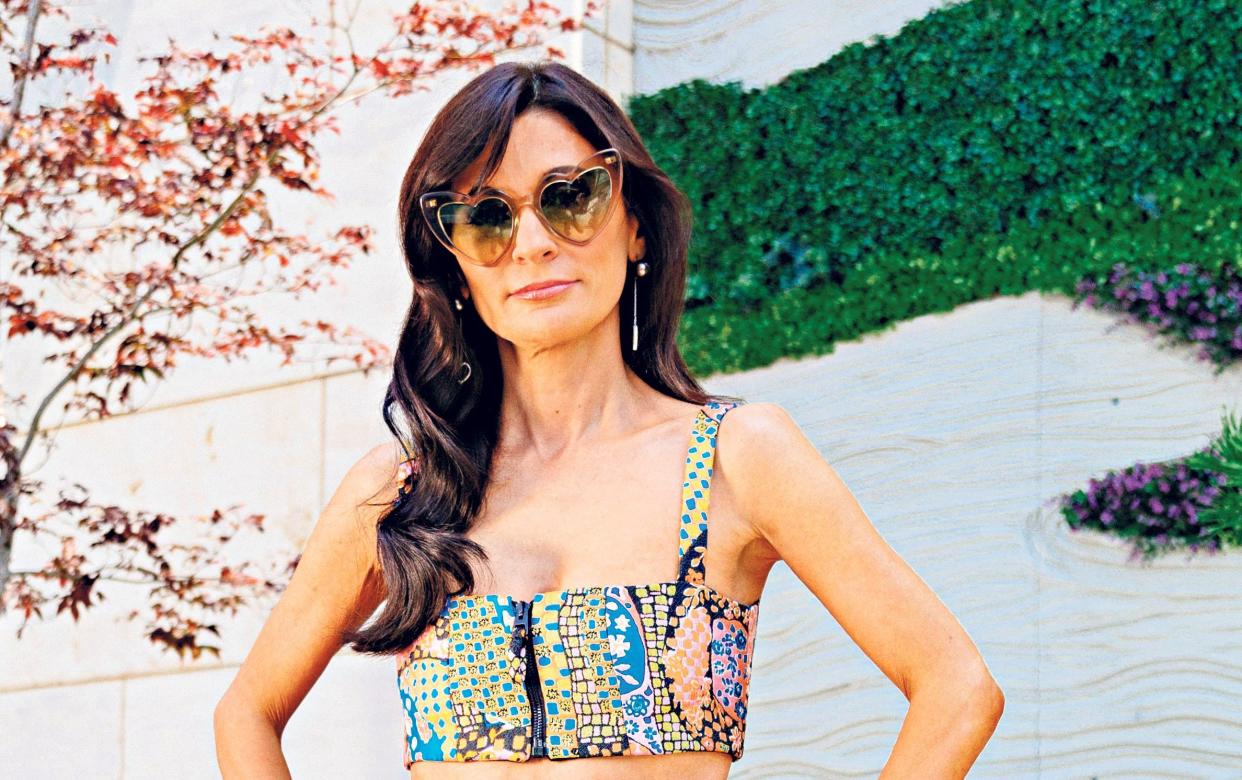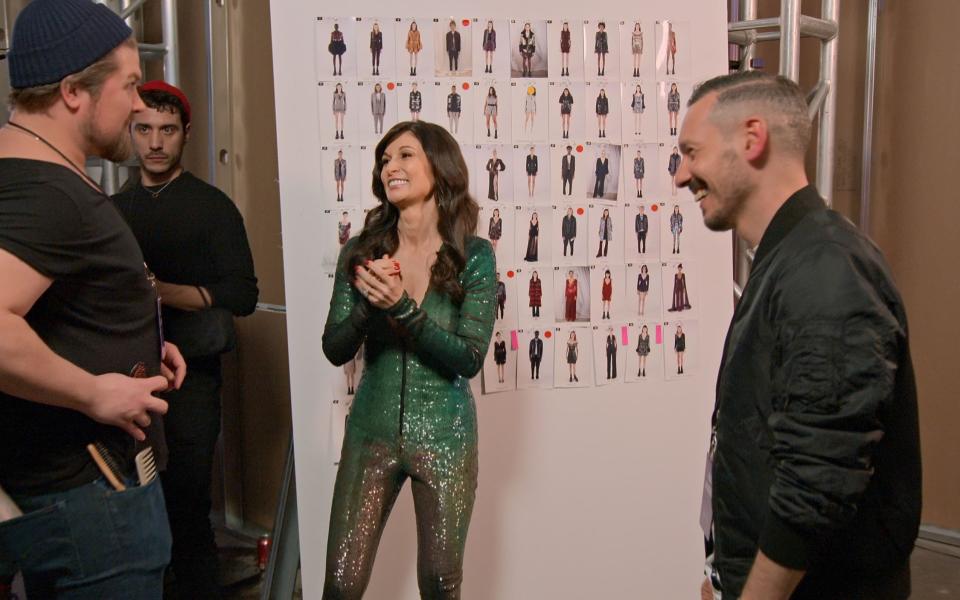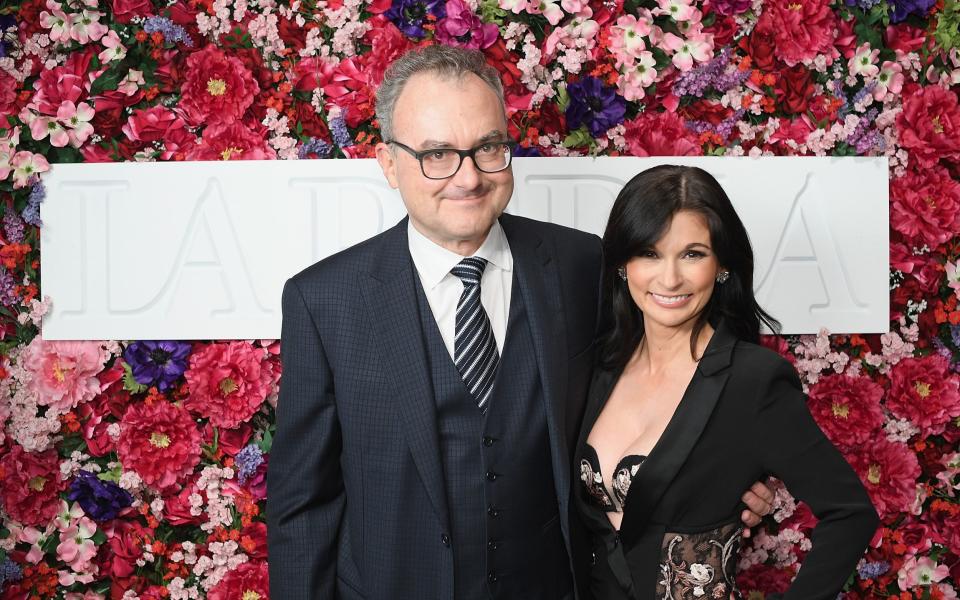Meet Julia Haart, who went from orthodox wife to fashion mogul at 50

“Let them stare!” Julia Haart laughs as she totters in towering heels and short shorts down supermarket aisles in upstate New York. The 50-year-old looks out of place among the modestly dressed Orthodox Jewish housewives – but it wasn’t long ago that she was one of them.
Born Talia Leibov, Haart was raised in an ultra-Orthodox community in Monsey, an hour outside Manhattan. But eight years ago, she abandoned the only life she’d ever known, changed her name and has since had a meteoric rise to become the CEO of one of the world’s best-known modelling agencies, which has Cindy Crawford and Naomi Campbell on its books.
Haart’s unlikely transformation from sheitel wig-wearing homemaker to fashion powerhouse at Elite World Group is the subject of new Netflix reality show My Unorthodox Life. Since it was released just over two weeks ago, the nine-part mini series has been hailed as the successor to last year’s Unorthodox – the TV hit of the first lockdown – a drama about a young woman’s attempts to flee her arranged marriage in Brooklyn and start a new life in Berlin, based on the true story of writer Deborah Feldman.
Such shows, including earlier Netflix drama Shtisel, have been spawned from the voyeuristic curiosity to pull back the curtain and have a good gawp at one of the world’s most insular communities. My Unorthodox Life is no different – little wonder it’s already been hailed as binge-watch of the summer. Or as the show’s tagline, repeated on Haart’s Twitter profile, puts it: ‘Unconventional and unstoppable’.
It’s a phrase that seems to sum her up. Freedom such as Haart’s can come with a high price: more often than not women – for it is mostly they who make the break – are cut off from their families and forced to forge their own way in life. Yet for Haart, it has brought the sort of wealth and success that has left viewers asking how she did it.
By Haart’s description, Monsey might as well be outer space. The quiet town of 22,000 people has become a centre of Hasidic life in America, with the largest Jewish population per capita of any US county. Its principal language is Yiddish.
Haart – who married her then-husband, Yousef, aged 19 – tells viewers she had always felt conflicted about living in a community where men were expected to study the Torah, and women to raise large families. She was, she claims, criticised for only having had four children.
The show follows Haart and her telegenic brood. The youngest, 14-year-old Aron, still lives with his father in Monsey – Haart’s trips back to see him paint a stark picture of the two different worlds she inhabits. Unlike many who reject Orthodox life, Haart has managed to keep a connection to it by way of her son, though is largely shunned by the wider community.
There is Batsheva, 28, a fashion influencer with over a million followers on TikTok, who is happily married to a man she wed as a teenager in Monsey, and Shlomo, 26, who keeps Kosher and is yet to kiss a girl.
But it was daughter Miriam who pushed her mother to leave, aged 43, with only a high school education and little job experience. As a child, Miriam, now a bisexual, free-spirited 21-year-old, would ask challenging questions: why weren’t girls allowed to ride bikes? Why couldn’t they play football, or attend the same school as boys?
“All the things I’d been thinking in my head, she was saying them out loud,” says Haart.
In 2012, Haart told Yousef that she was leaving, taking only Miriam with her. Aron remained in the community, Shlomo was studying in Israel, and Batsheva was then newly married. All but Aron would later join their mother.

Haart emphasises that she did not simply walk. Her departure played out over eight years, in part because she was terrified of losing her children. In the ultra-Orthodox world, women are not allowed to divorce men, who are almost always granted custody.
She read voraciously to learn about life “outside” and began secretly selling life insurance in order to squirrel away an escape fund. She contacted one of the few friends she had in Manhattan to help her get started.
Yousef tried to convince his wife to stay but ultimately did not attempt to stop her. He is set up to seem like a monster, but in later episodes encourages his son to cast off some of his more extreme beliefs, and appears kind and understanding.

Haart says her transition was tough. For more than three decades, she’d had no regular access to radio, TV or newspapers. She’d never been to a bar or even slept in a room on her own. She did have some applicable skills, having taught herself how to sew from fashion magazines she smuggled home as a teenager and regularly making her own clothes.
Yet the series leaves some questions unanswered, like how does a 40-something who has never lived in the “real world” ascend to a top job in fashion?
Clues lie in Haart’s forthcoming autobiography, Brazen, in which she writes about starting to design her own shoes – glamorous but comfortable – just weeks after leaving Monsey, soon finding loyal customers. Her break came after a board member of La Perla heard about Haart’s shoes from female colleagues and the Italian luxury lifestyle company brought her in to design supermodel Kendall Jenner’s notorious thong-baring beaded gown for the 2017 Met Gala.

It was at La Perla that she met the company’s CEO, Silvio Scaglia, now her husband. Before Scaglia, who has added Haart’s surname to his own, Julia had never been on a date, “never been kissed by someone I had chosen.”
In 2019, Scaglia, who founded a company that controls Elite World Group, brought Haart in as co-owner and the chief executive of the modelling conglomerate. She has since created in-house fashion brand, e1972.
Haart, who kept her former life secret until now, has seen great success. When she joined, the company was valued at $90 million (£65 million). Today, she has valued it at “slightly over $1 billion”. She puts it down to doing business differently and sees it as her mission to end the exploitation of women in the modelling industry, having experienced that feeling of powerlessness in her own life.
The critical reception to the Netflix show has been mixed. Some detractors accuse Haart of exaggerating the situation for women in the Orthodox community for entertainment, while others say the depiction is far from helpful at a time when anti-Semitism is on the rise. In December 2019, a man wielding a machete broke into the home of a Hasidic rabbi in Monsey, stabbing five people and killing one. It was the tiny town’s second such incident in a month.
One Jewish newspaper has even launched a social media campaign to combat Haart’s “harmful” narrative by encouraging men and women to share their “satisfying, healthy and fulfilling Orthodox lives,” using the hashtag #MyOrthodoxLife.
Michla Berlin, who says she grew up near Haart in Monsey, claimed that the impression that Orthodox children had limited educational opportunities wasn’t the reality.

“Women and girls were not less than. We were not kept, we were not suffocated or silenced,” she says. “The version of our wonderful Monsey you are skewing and showing the world never even existed.”
Haart says she has received messages of hate from her old community, but a number have reached out for advice. In one episode, a girl named Sara asks her for help to leave. Haart gives her a makeover and promises to help her find a job.
She has been at pains to make clear in recent interviews that it’s not religion that she has an issue with, but “extremism” in any form, saying: “My issues and the way that I was treated have nothing to do with Judaism... I feel very proud to be a Jew.”
The show’s release comes at a time when Orthodox women are, conversely, taking on increasingly visible roles – from New York City Council hopeful Amber Adler to state judge Rachel Freier. In Monsey there have been rare public protests by women, calling for men to give their wives the right to divorce. They have a growing campaign online, a space previously thought unacceptable.
At its core, My Unorthodox Life is less about religion than self-expression. It took leaving for Haart to figure out who she was and what she was meant to do.
As she puts it: “Maybe someone will watch the show and say, ‘Well, if this crazy woman can do it at 43 with no education, knowing no one in the outside world, I can do it too.’”
My Unorthodox Life is available now on Netflix


